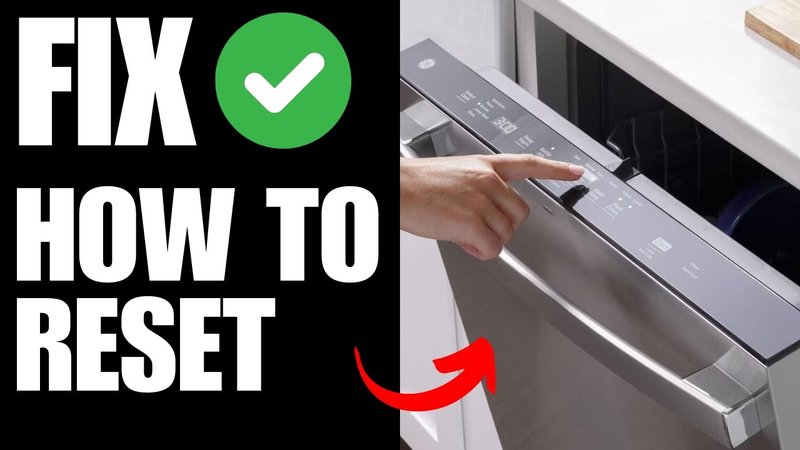
In simple terms, the “F1” error code on a GE dishwasher indicates a problem with the water inlet valve. Think of it like a water hose with a kink in it, preventing water from flowing properly. This error might leave you feeling frustrated, but often, it’s not as dire as it seems. Before you start panicking or considering a call to the repairman, there’s a chance that resetting your dishwasher might clear the error and get things back on track. But how do you do that, and what if it doesn’t work? Let’s break it all down.
Understanding the Error Code F1: What It Really Means
When your GE dishwasher flashes the “F1” error code, it’s like the appliance is trying to send you a message. This code usually points to an issue with the water supply, specifically the flow into the dishwasher. Picture it as a gate not opening fully, restricting the water necessary for optimal cleaning. The root of the problem can vary—from a clogged water inlet valve to issues with water pressure or even a glitchy control board.
It’s important to remember that while an error code feels like a big red flag, it doesn’t always mean catastrophe. Sometimes, these error codes are just the dishwasher’s way of prompting a system check or indicating a minor glitch. In many cases, performing a simple reset can clear the code, like rebooting a sluggish computer to refresh its operations.
Keep in mind, however, that if the issue stems from a mechanical problem, like a defective valve or a damaged hose, a reset might not be a lasting solution. It’s akin to applying a bandage to an ailment needing more substantial treatment. So, while a reset is often a helpful first step, further investigation might be necessary to keep the dishwasher running smoothly in the long run.
How to Reset Your GE Dishwasher
Resetting your GE dishwasher is like turning it off and on again, simply rebooting the system to clear any temporary faults. To do this, start by disconnecting the dishwasher from power. You can achieve this by unplugging it or flipping the circuit breaker that supplies power to it. Leave it off for about 2-5 minutes; this gives the electronics time to reset themselves.
After a few minutes, reconnect the power. The dishwasher’s system should reboot, clearing minor glitches and, ideally, the pesky F1 error code. Turn it back on and check to see if the error persists. If it’s gone, fantastic, you’re likely in the clear—for now. But don’t place that call to celebrate just yet. It’s wise to keep an eye on its performance for the next few cycles to ensure there are no reoccurring issues.
If the error code returns after the reset, it might be time to dig deeper. This could mean checking for other signs of trouble like water pooling inside the dishwasher, unusual noises, or incomplete cleaning cycles. These are clues that might point toward a bigger issue that requires more than just a reset.
When Resetting Isn’t Enough: Troubleshooting Tips
Sometimes, like a stubborn sneeze that refuses to go away, your dishwasher’s problems might need more than just a reset. If the error code keeps flashing its unwelcome presence, it’s time to roll up your sleeves and do some deeper inspecting. Start by considering the water inlet valve; it can become clogged or defective over time, much like a garden hose that gets blocked.
To inspect this, you might need to turn off the water supply and remove the valve for a closer look or even a replacement. Another area to investigate is the water pressure. If your home’s water pressure is lower than recommended, it can lead to issues with the dishwasher’s operation, triggering that F1 code.
Finally, ensure that the connections and hoses are intact and free from kinks or damage. Just like a straw with a hole in it disrupts your ability to drink properly, any leakage or obstruction can impede your dishwasher’s ability to function correctly. If these troubleshooting steps seem daunting, don’t hesitate to consult the dishwasher’s manual or reach out to a professional technician.
Preventing Future Issues: Keeping Your Dishwasher Running Smoothly
Preventative maintenance is the name of the game when it comes to avoiding error codes and keeping your dishwasher in tip-top shape. Regularly inspect and clean the water inlet valve and filters; this reduces the likelihood of clogs and ensures a steady flow of water. You can think of this as keeping your car’s oil clean—necessary for smooth operation.
Additionally, be mindful of what you’re putting into your dishwasher. Avoid overloading it or placing large items that could block the spray arms. Consider running a cleaning cycle every so often with a mixture of vinegar and baking soda to keep things fresh and prevent buildup.
Lastly, familiarizing yourself with the user manual can be immensely helpful. It’s like having a road map for your appliance, with tips and recommendations straight from the manufacturer. With these steps, not only can you keep pesky error codes at bay, but also extend the life and efficiency of your dishwasher—saving you time, frustration, and money in the long run.